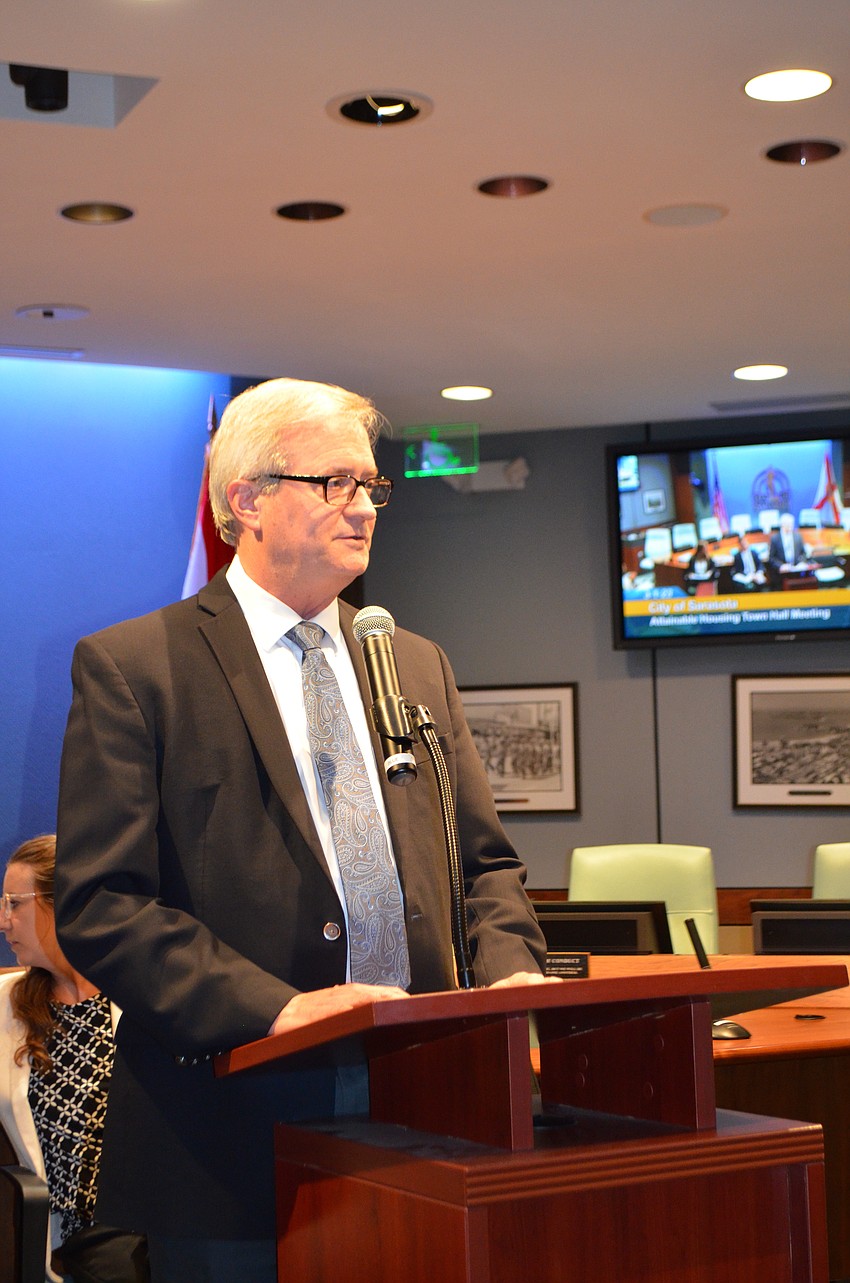- April 9, 2025
-
-
Loading

Loading

With the approval of four separate motions on Monday by the Sarasota City Commission, the city is just a second reading approval away from an ordinance to incentivize the development of affordable and attainable housing in the downtown zoning districts.
Waiting in the wings, according to Planning Director Steven Cover, are three projects ready to launch the administrative review process once final approval is achieved.
Specifics of those projects were not disclosed.
Monday’s legislative hearing marked the peak of nearly a year’s work by planning staff to draft zoning text changes made possible by amendments to the city’s comprehensive plan that were approved in fall 2022. It is the city’s first foray into such zoning changes with an eye toward expanding the incentives in areas outside the downtown districts.

During Monday’s meeting, commissioners grilled planning staff and debated for nearly five hours among themselves some of the finer points of the ordinance. Those included sidewalk and parking incentives that permit additional density, dispersion of attainable units among market rate units within a single structure, and why a 15% minimum of bonus density units earmarked as attainable really equals only 11.25% of all units available below market rate.
Why, Cover was asked by commissioners Jen Ahearn-Koch and Debbie Trice, could the ordinance not require 15% of all units to be attainable.
“If we just use the flat 15% for the entire project, let’s say you have a project that only wants to go from 50 units to 60 units. That means nine of the 10 additional units would have to be attainable,” Cover said. “No developer is going to do that. Even if you go to 100, that means 30% of the additional units would be attainable. We think 30% is not a doable number, and we don't think any developer is going to do that. So that's why we have 15% of all the bonus density above the base density (as attainable)."
Among the requests that surfaced through previous meetings with neighborhood organizations in the affected zoning districts was a requirement for such developments to hold public workshops. Currently, all downtown zoning district developments are administratively approved, a process that does not require workshops.
That set off a debate among commissioners with Ahearn-Koch and Trice supporting workshops, Commissioner Eric Arroyo and Mayor Kyle Battie opposed and Vice Mayor Liz Alpert vacillating somewhere in between.
“I almost find it discriminatory. We don't to do it in any other project downtown,” Battie said. “Why attainable housing when that's what we're trying to achieve? We don't do it with any other luxury apartments. Why do we have to do it with attainable housing?”
Ahearn-Koch countered that her support of public workshops wasn’t based on the type of housing, but rather the intensity of qualifying projects.
“I don't want to characterize this as luxury housing versus affordable housing,” she said. “Nobody is dissing or being discriminatory against people who need affordable housing. The density is what's driving the request, not the housing itself.”
Arroyo said adding workshops to the approval process when they cannot impact the outcome is an unnecessary obstacle for a developer willing to help the city meet its attainable housing needs.
“It's already difficult enough to get individuals to provide this,” Arroyo said. “Sarasota is a very attractive area and it's already competitive enough just trying to get them to accept less money. We’re saying you’re going to have these additional steps, and that if we want this to succeed, then we need to really consider that.”
Occupying the middle ground for a time, Alpert leaned away from workshops by reasoning that they may create an expectation that the neighborhood input would have any effect on the approved project.
“I don't want to give the false impression that if there was a public workshop you can stop the project if it's complying with all of the ordinances,” Alpert said. “I don't want to create a false expectation.”
She then asked Cover if workshops were required, “At what point? It seems like at the beginning before a lot of plans are drawn up. Any thoughts on that?”
“If a project is coming in and meeting all the zoning requirements, then you're right, there really isn't anything anybody can do,” Cover said. “If they're requesting additional things that might require a special review by the director development services, then you could discuss that. But if it meets all the zoning requirements, the applicant doesn't have to make any changes.”
Approval of the ordinance required four motions, three of them amendments and all posed by Arroyo. The first excluded a public workshop requirement. That passed 3-2 with Ahearn-Koch and Trice opposed. A second amendment motion by Arroyo was to clarify that either owner-occupied or rental attainable units be interspersed at a minimum at 50% across a development, which was approved unanimously. His third amendment motion was to clarify allowing for a height bonus of one story if a minimum amount of public parking or public parking combined with setbacks allowing for wider sidewalk, which was approved 4-1 with Ahearn-Koch opposed.
Finally, Arroyo motioned to approve the entire ordinance as amended, which received unanimous support.
The second reading of the ordinance and consideration for final approval will be placed on the City Commission's agenda at a future date.